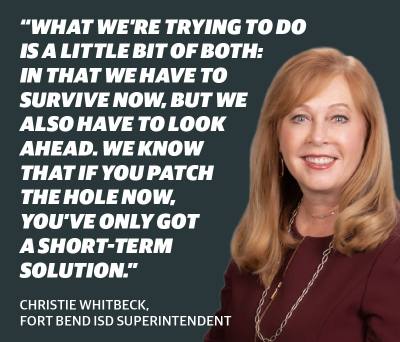In comparison, FBISD has faced at least a $19 million deficit over the last two years, both in FY 2021-22 and FY 2020-21—the first significant deficit it has faced in 13 years.
District officials have proposed implementing both temporary and longer-term solutions aimed at bridging the shortfall, including the use of $27 million in unallocated federal Elementary and Secondary School Emergency Relief funds granted to the district from the Coronavirus Response and Relief Supplemental Appropriations Act.
“If your enrollment [and] your student attendance is down, you’re not going to be bringing in revenue for your school districts in order to provide the pay raises [or] to bring in additional support staff,” said Bob Popinski, senior director of policy for education advocacy group Raise Your Hand Texas.
Key to the shortfall has also been lower-than-expected enrollment, officials said. When the FY 2021-22 budget was created, FBISD anticipated an $18 million loss in revenue due to enrollment. The loss ended up hitting $19 million.
In the FY 2022-23 budget, of the roughly $49 million shortfall, $26 million is attributed to enrollment, while the other $21 million stems from increased expenditures to fund staffing and facility expansions as well as compensation increases, officials said.
While using ESSER money may cover a $27 million portion of the shortfall, the district will utilize its fund balance to make up the difference. The ESSER funds must be used by August 2024, which means FBISD needs a more long-term solution, officials said.
“What we’re trying to do is a little bit of both: In that we have to survive now, but we also have to look ahead,” FBISD Superintendent Christie Whitbeck said.
Insufficient funds
Chief Financial Officer Bryan Guinn said 2,400 fewer students enrolled over the last two years than what was projected by FBISD’s demographer, Population and Survey Analysts.
During the pandemic, much of the district’s slow down in enrollment growth occurred in students at the early education to fifth-grade level, according to a Feb. 14 PASA update. During the 2020-21 school year, FBISD saw about a 1,500-student decline.
According to the Texas Education Agency, Texas school districts receive most funding from local property taxes and the state, which allocates funding based on average daily attendance and a formula that allots a minimum of $6,160 per student for FBISD sized districts.
The expansion of public charter schools also played a role in exacerbating enrollment challenges, district officials said. From 2015-20, the number of students in FBISD boundaries who instead enrolled in charter schools increased by 71%, according to PASA.
“In a case where you have two campuses relatively close by, you begin to dilute the funding because the charter is receiving a portion and the district is receiving a portion,” Guinn said.
Pandemic-related hurdles and staff raises also affected the budget, district officials said. In the 2020-21 school year, FBISD was unable to provide typical annual increases—which are usually around 2%-3%.
To justify not increasing compensation, teachers received a 6% average pay bump during the 2021-22 school year, while non-teaching staff received a 4% bump. That raised the starting teacher pay from $55,500 to $58,500. In total, that pay increase cost the district $32.4 million, Guinn said.
That expense, combined with a $46.8 million shortfall due to decreased enrollment and pandemic-related expenses, put FBISD in a tight budget position headed into the 2022-23 school year, officials said.
Shortfall repercussions
Heading into the 2022-23 school year with a proposed $46.8 million shortfall, parents, staff and students are beginning to feel the effects, including smaller teacher pay increases and fewer support staff.
These ramifications come as the district faces a 73-day fund balance reserve, meaning less money for emergencies or to fill a budget deficit. District policy requires at least a 90-day reserve.
While FBISD teachers were given a 6% average compensation increase in the 2021-22 school year, the board authorized a 2% starting salary bump for the upcoming school year during a May 16 meeting while providing existing teachers a $1,500 raise, an increase some teachers said is not enough.
“A 2.3% increase, or $1,000, is disrespectful,” said Glenda Macal, president of the Fort Bend American Federation of Teachers union, during a May 9 board meeting.
However, Guinn said the 6% average increase in the 2021-22 school year made the district more competitive with the local market.
In 2021-22, FBISD first-year teachers were paid $58,500 per year. In the same year, Katy ISD’s first year teachers were paid $57,365, while Houston ISD’s first-year teachers were paid $56,869, according to data from the districts. The average teacher starting salary in Texas was $44,527 for FY 2020-21, according to state data provided to the National Education Association, a labor union representing 3 million teachers and support staff.
To cut spending, FBISD also either froze or eliminated $1.6 million worth of noncampus positions, Guinn said. Not eliminated or frozen are FBISD’s learning loss interventionists, who focus on catching students up to their peers across all grade levels, Chief Academic Officer Kim Lawson said.
The district employed campus interventionists at each elementary school before the pandemic but hired an additional 10 literacy and five math itinerant interventions using a portion of the $13 million in ESSER funds, said Melissa Hubbard, the district’s executive director of teaching and learning.
These interventionists look to help children and parents navigate learning loss across the district’s programs, including the Succeeding in Academic and Independent Living Skills, which is designed to teach special needs students important life skills.
However, Jennifer Dobias’ daughter, who attended the program during the pandemic, struggled with an inconsistent schedule and the switch from virtual to in-person instruction. Because of this, Dobias transferred her to a private school for special education with the hope of catching her up by August.
“That will give her plenty of time to be up to speed and to hopefully transition back into public school,” she said.
Next steps
Utilizing ESSER funds may allow the district to meet its 90-day reserve requirement for the proposed FY 2022-23 budget—but as FBISD looks beyond this year, it will need a recurring revenue source to meet future fund needs, Guinn said.
FBISD has forecasted with the addition of new facilities and staff to fill those facilities as the district grows, with no corrective financial supplement in place, the budget shortfall will grow to $75.7 million by the 2024-25 school year.
One proposal from the district to help make up the shortfall in future years is a voter-approval tax rate election. If voters approved one in November, the district would be able to increase its tax rate to increase the district’s revenue.
That means a $0.02 increase proposal approved by voters would cut the projected 2024-25 school year shortfall down from $75.7 million to $55.4 million.
“While it doesn’t fix our problem, it gives us some capacity to deal with the ongoing revenues in a consistent way,” Guinn said.
The possibility of a tax rate election comes as the district looks to meet its growing needs by spending $3.55 million to add 69 positions for the 2022-23 school year, including 27 special education teachers. In addition, at its May 16 meeting, the board approved pay changes worth $14.7 million. Starting in the 2022-23 school year, the starting teacher pay will go from $58,500 to $59,500.
Meanwhile, Whitbeck said it is “highly likely” a bond election is on its way in 2022 to meet the district’s growing facility needs. The last bond, at nearly $993 million, was approved by over 70% of voters in 2018.
“Those needs—like roofs, HVAC systems and the growth in the district—have not changed,” Whitbeck said.






